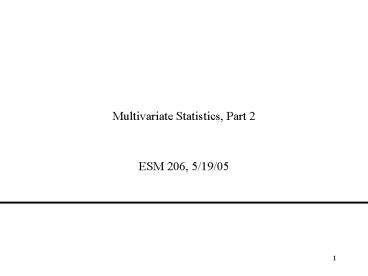Multivariate Statistics, Part 2 - PowerPoint PPT Presentation
1 / 12
Title: Multivariate Statistics, Part 2
1
Multivariate Statistics, Part 2
- ESM 206, 5/19/05
2
Cluster analysis
- Ordination organizes the samples along a set of
latent variables that are continuous - Cluster analysis organizes the samples along a
set of latent variables that are categorical - Find a set of discrete clusters such that the
observations within a cluster are much more
similar to each other than they are with
observations in other clusters
- Requires some notion of distance in the
P-dimensional space - Euclidean distance
- Mahalanobis distance Like Euclidean but takes
statistical correlations into account - Dissimilarity coefficient often used for count
data of species - Non-hierarchical clustering
- Get just the clusters
- Hierarchical clustering
- Also get similarities between clusters
3
Community composition at 6 sites
4
(No Transcript)
5
Cluster Analysis
- Makes very few assumptions about data ?
- Lots of options and they matter ?
- Distance measure
- Agglomerate or divide
- Rules for growing or dividing clusters
- Other challenges
- Only finds spherical clusters
- Finds clusters even when data are following
continuous variables - If this is true then different approaches will
build very different clusters
6
(No Transcript)
7
(No Transcript)
8
Discriminant Analysis
- Have predefined groups each observation has
unique value - Presence or absence of a species
- Political party affiliation
- Vegetation type
- Also have set of continuous variables measured at
each observation - Want to find linear combinations of continuous
variables that best discriminate among the groups - Sort of like logistic regression
9
(No Transcript)
10
Example presence/absence of a marine invertebrate
- Data from EPA EMAP surveys in estuaries on US
east coast - Presence/absence of Mediomastus ambiseta
- Data on 16 water quality variables
- Salinity, temperature, etc. at surface and bottom
11
Stepwise procedure suggests most discrimination
from surface salinity and pH PAR at bottom
12
Classification accuracy
- Confusion matrix
- Kappa statistic































